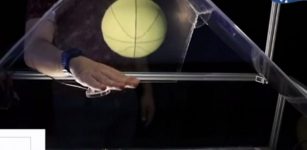MilliMobile: Tiny, Self-Driving Robot Powered Only By Light And Radio Waves
Eddie Gonzales Jr. – MessageToEagle.com – Researchers at the University of Washington have now created MilliMobile, a tiny, self-driving robot powered only by surrounding light or radio waves.
The tiny robot is able to move across a variety of surfaces, including concrete and packed soil.Mark Stone/University of Washington
Equipped with a solar panel–like energy harvester and four wheels, MilliMobile is about the size of a penny, weighs as much as a raisin and can move about the length of a bus (30 feet, or 10 meters) in an hour even on a cloudy day.
The robot can drive on surfaces such as concrete or packed soil and carry three times its own weight in equipment like a camera or sensors. It uses a light sensor to move automatically toward light sources so it can run indefinitely on harvested power.
Small mobile robots carrying sensors could perform tasks like catching gas leaks or tracking warehouse inventory. But moving robots demands a lot of energy, and batteries, the typical power source, limit lifetime and raise environmental concerns. Researchers have explored various alternatives: affixing sensors to insects, keeping charging mats nearby, or powering the robots with lasers. Each has drawbacks. Insects roam. Chargers limit range. Lasers can burn people’s eyes.
Researchers at the University of Washington have now created MilliMobile, a tiny, self-driving robot powered only by surrounding light or radio waves. It’s about the size of a penny and can run indefinitely on harvested energy.Mark Stone/University of Washington
“We took inspiration from ‘intermittent computing,’ which breaks complex programs into small steps, so a device with very limited power can work incrementally, as energy is available,” said co-lead author Kyle Johnson, a UW doctoral student in the Paul G. Allen School of Computer Science & Engineering. “With MilliMobile, we applied this concept to motion. We reduced the robot’s size and weight so it takes only a small amount of energy to move. And, similar to an animal taking steps, our robot moves in discrete increments, using small pulses of energy to turn its wheels.”
The team tested MilliMobile both indoors and outdoors, in environments such as parks, an indoor hydroponic farm and an office. Even in very low light situations — for instance, powered only by the lights under a kitchen counter — the robots are still able to inch along, though much slower. Running continuously, even at that pace, opens new abilities for a swarm of robots deployed in areas where other sensors have trouble generating nuanced data.
These robots are also able to steer themselves, navigating with onboard sensors and tiny computing chips. To demonstrate this, the team programmed the robots to use their onboard light sensors to move towards a light source.
The team will present its research Oct. 2 at the ACM MobiCom 2023 conference in Madrid, Spain.
Written by Eddie Gonzales Jr. – MessageToEagle.com Staff












